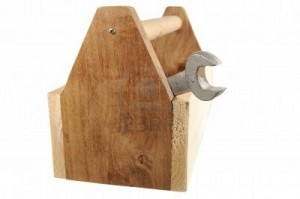 The power is out…again. Gas is over $10/gallon…when stations actually have gas to sell and electricity to run their pumps. Combined state and federal sales taxes under the Leveraged Index Financial Emerging Liabilities Interoperable Nullification and Easement (LIFELINE) Act of 2013 are at 25%…making a $5 half gallon of milk $6.25. Unemployment numbers (uncorrected) are close to 30% and underemployed numbers account for 12% more, leaving close to 50% of Americans below the poverty line for the first time in generations as companies shut down or move out of the country for easier economic climates.
The power is out…again. Gas is over $10/gallon…when stations actually have gas to sell and electricity to run their pumps. Combined state and federal sales taxes under the Leveraged Index Financial Emerging Liabilities Interoperable Nullification and Easement (LIFELINE) Act of 2013 are at 25%…making a $5 half gallon of milk $6.25. Unemployment numbers (uncorrected) are close to 30% and underemployed numbers account for 12% more, leaving close to 50% of Americans below the poverty line for the first time in generations as companies shut down or move out of the country for easier economic climates.
The dollar is trading below the Mexican Peso since the Mexican government allied with the Brazilians to drill in the Gulf of Mexico. Environmental restrictions on coal, natural gas, and fracking have the production volumes selling at 375 times the cost of 2010. Increasing brownouts and blackouts are happening across the grid to save on fuel. The average family who cannot afford a power ration exemption, can expect to be without power at a minimum of 7 hours a day, often much longer.
Yes, I’ve just spun a yarn, but is it really a stretch? I don’t believe so. Consider, for a moment, living in the world I have just described to you. Will you be able to buy cheaply made mass produced goods from Wal-Mart when your dollar buys less than 60% of what it did in 2008? Will you be able to profligately use electricity for everything or drive your car down the street for a loaf of bread and pack of $25 cigarettes? What about replacing your goods as these thing break or wear out? Will you be able to repair or replace them? Do you have the means?
You do, you say? You have you grandfather’s wood shop or your father’s garage is full of tools so you should be able to figure it out, you say? Necessity is the mother of invention, they always say…right? You tell me. What do MOST of those tools have in common? Look close…no, look again. YES! Most of them require electricity to run. Well HECK!!! That pressboard and veneered plywood furniture is going to last much longer. You were going to repair that bed frame with your buzz box stick welder from Harbor Freight, right? Soooo, now what are we going to do?
 Roy Underhill at his shaving horse with a drawknife in hand.
Roy Underhill at his shaving horse with a drawknife in hand.
How about going old school? Let’s get a little Norm Abrams or Roy Underhill in our hearts. Before the 1940’s, most people did not have access to electric powered tools for personal use. Consider the possibility of returning to those days. They used hand tools for many things. So, let us, too, consider them.
The use of hand tools is a rather arcane art anymore. Why plane and scrape a project for hours when a few passes on the jointer, then planer, and some powered sanding does the job in less than 90 minutes? Because NOW you can’t and because, maybe, you might find some satisfaction in doing a job the old fashioned way.
So let us look at some useful tools to have, for anybody, in a post-rolling brown-out world.
Saws
We always need to size our wood pieces and saws are the best, most efficient, cleanings, and exacting tools that we have for this purpose. Saws can be classified by design, purpose, origin, cutting mechanics, and many more criteria and this can be daunting to the uninitiated. For the purposes of simplicity, we will only look at the important criteria, and let your experiences and learning curves dictate the rest.
Design is the best criterion that is also the easiest criteria to use, in my experience. WESTERN saws (more on these eastern/western differences later) are generally divided up into rip cut, cross cut, and combination saws. There are specialized saws but these will be addressed later. A rip cut is a cut designed to cut with the grain of the wood (i.e. lengthwise), while a cross cut cuts across the grain of the wood (perpendicularly or at an angle). A combination saw is just what it sounds like, a saw designed to do both. Saw tooth design and pitch determine the type of saw that it is classified as.
Next thing to consider are the mechanics of saws. Saws are designed with certain types of strokes and mechanics. Most saws cut in a single direction. In the western world, most hand saws cut in the downward stroke, while clearing the kerf (the channel created by the saw removing wood material) on the upstroke. You will know if you have an efficient stroke if the saw dust piles up in front of the teeth. Saws work better with full stokes at comfortable angles.
Eastern, or Japanese, saws are generally the opposite with the cut being on the upstroke. Buck, limbing, and planking saws (think old stereotypical lumberjack saws) cut it both direction and clear the kerf at the same time.
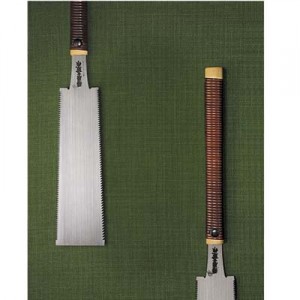 Japanese styled saws-notice the ergonomics are different in handle design
Japanese styled saws-notice the ergonomics are different in handle design
Specialized saws to consider are gent’s or dovetail saws, miter saws, and coping saws. At a minimum, a prepper will have at least a 12-14” combination saw, a coping saw, and miter saw, as well as a woodsman bow or limbing saw. For more detailed work, gents’s or dovetail saw and a variety of Japanese saws will be in your repertoire.
Saws can be expensive but saws, with some TLC, can be refurbished. Keep them dry and clean the pitch and sap off of them. Be careful of the type of wood that you are cutting. Some woods are extremely dense, like ebonies and maples. Others are very resinous and require a lot of cleaning after use, like pines, and other evergreens. Some are very coarse grained and can cause rip cuts to go astray without careful cutting, like oaks and zebrawoods.
This is by no means an exhaustive lesson on saws, merely a primer. So what else should a Prepper have in their tool box?
Hammers
For a multi-tool that seems so simple at first, a neophyte heading to the hardware store might be overwhelmed at the choices. First, there are different hammer heads for different applications. What do all these different handles mean? Why are the striking faces so different? It looks so simple so why am I bending all these nails or wearing myself out?
Let us simplify the answer by looking only at wood purposed hammers. Masonry, peen, slag, drilling, sledge, roofing, and drywall hammers all have their places and uses but for the woodworking discussion we will limit it to framing, finish, tack, deadblow, and mallet hammers.
Of these hammer types, the heads are very unique. The head designs are the easiest way to readily identify them. With time and practice, feel alone will tell you which hammer you have selected.
Notice the different framing head designs and the newer nail starter notches.
Framing hammers are generally heavier than most others (16-28oz) and are characterized by a pronounced and sharp nail puller that is not very curved and can act as a lever for lumber during construction. The striking faces can be squarish and round. The face is flattened with either and smooth or a waffled finish. The waffled finish reduces the strike face’s tendency to glance off of nail heads during bad blows and improper swings. (Note: the waffled heads can and WILL turn thumbs to purple hash and plums sometimes as any carpenter can attest to.) The new framing hammers, or framers, may have a magnetic notch in the top to assist with nail starting but as a person swinging hammers for over 3 decades, I am not a fan. Additionally, the strike faces are wider than other hammer types and in the case of California styled framers, the head is very pronounced.
The handles are important. Traditionally, framers have hickory or ash handles. For the same reason that they are used for baseball bats, these two woods absorb percussive damage very well and reduce vibration, better than denser woods, like maple, for example. Estwing, back in the day, turned the industry upside down with their, then revolutionary steel handle design that is still favored by many carpenters today. Fiberglass and composite handles are making a larger impact on the market, due to their imperviousness to weather and excellent durability and shock absorbency. Handle design is getting more involved these days, as well. My concession to newer handle designs came during my first trip to respond to Hurricane Katrina when I got ahold of a then new Stanley ergonomic handled framing hammer. This composite-steel hybrid with the rubber shock handle and space age design won me over. It really reduced hammer fatigue over the course of a work day. It had some trade-offs though. It was not as heavy as I like (only 20 oz) and the curved handle made nail pulling and levering more difficult.
Finally, handle length is important. In the US, overall framer length is 16 inches. This is for good reason. It provides a fast measuring reference for quick framing since the standard stud spacing is 16” in the US. Simply lay your hammer down, mark 16”, place your stud, and secure it, then move on. The exception to this is the California framer which can have an overall length of up to 20+inches. This allows the heavier heads (24+oz) to work more efficiently by utilizing gravity more. My Craftsman hickory handled California framer has seen some work, let me assure you of that.
Next, we will look at finish hammers. These are the ubiquitous hammer in everybody’s house. They come in all sorts of sizes. They are as light as 8 oz and as heavy as 20 oz. The most common size is 16 oz and I use that. The heads have the distinctly curved nail pullers with a smooth top to allow one to work in tighter areas and to reduce marring surrounding wood. The strike faces are both round and rounded to allow light, multi-angled glancing blows to finish and other small headed nail fasteners. The strike face reduces marring the surrounding wood from mis-strikes, as well.
Finish Hammer
The handles are wood or fiber/composite. The length varies. The purpose of these hammers is to increase hammer control, reduce damage, and to drive smaller fasteners in a way that is not damaging or aesthetically unpleasing.
Tack hammers look almost like toys. They are usually under 8 oz. Their heads resemble clunky tuning forks from the top and their handles are small. These hammers are specialty woodworking hammers to drive small tacks and nails in to tight and delicate projects, like picture frames or jewelry boxes.
Deadblow mallets are usually barrel shaped heads encased in rubber or soft plastic. They are weighted with lead shot or sand to have a shifting weight displacement and to dampen vibration. They are not designed to strike metal. They are used to fit wood pieces together by striking the wood without marring it. They can range in weight from 8 oz to over 28 oz.
Wooden mallets are often used in the same way as dead blow hammers. Their heads are squared off blocks of dense woods like maple or beech. They can dead blow or they can drive biscuits, dowels, and plugs. They are extremely useful woodworking tools.
Wooden Mallet
Stay tuned to the next part of the series where we look at wood processing tools briefly, like axes, adzes, froes, etc. We will also begin to look at wood shaping and finishing tools, like chisels, planes, and scrapers.
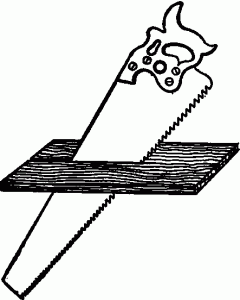
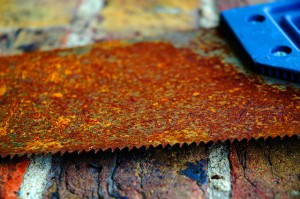

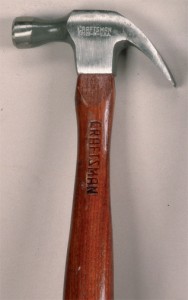

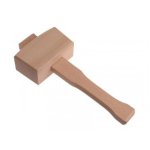
No comments:
Post a Comment